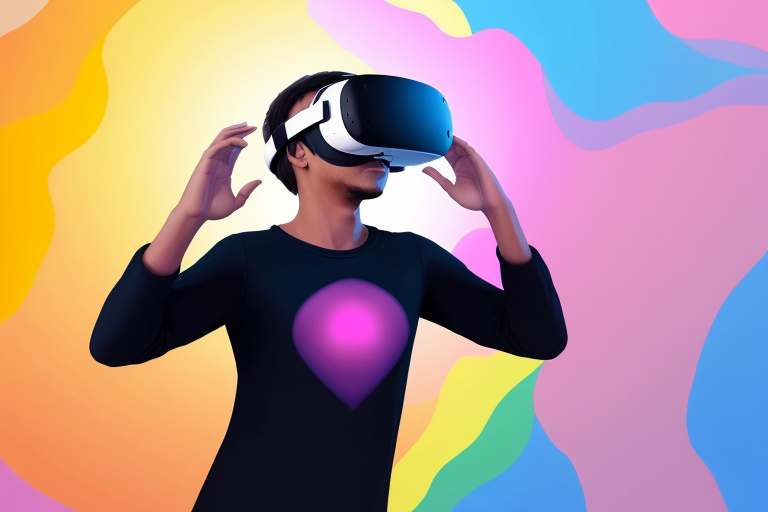The Rise of Virtual Reality Gaming
Virtual reality gaming, or VR gaming, is an immersive gaming experience that allows players to interact with a virtual world using a headset and other input devices. With VR gaming, players can feel like they are part of the game, experiencing everything from the perspective of their avatar.
VR gaming has become an increasingly important part of the entertainment industry in recent years, with more and more people looking for new and exciting ways to experience video games. The technology has come a long way since its inception, and today’s VR games offer a level of immersion that was once thought impossible.
The history of VR gaming dates back to the 1960s, when Ivan Sutherland developed the first head-mounted display (HMD) system. However, it wasn’t until the 1990s that VR gaming began to gain popularity, with the release of arcade games like Dactyl Nightmare and Virtuality. These early VR games were primitive by today’s standards, but they laid the foundation for what was to come.
In the early 2000s, VR gaming fell out of favor as the technology proved too expensive and cumbersome for most consumers. However, with the release of the Oculus Rift in 2012, VR gaming began to make a comeback. Today, there are a variety of VR headsets available, each with its own unique features and capabilities.
With the current state of VR gaming, players can experience a wide range of games, from first-person shooters to puzzle games. Some of the most popular VR games include Beat Saber, Half-Life: Alyx, and Superhot VR. These games offer a level of immersion that is unmatched by traditional video games, allowing players to feel like they are truly part of the game world.
As we move into the future, the potential for VR gaming is limitless. With advancements in technology, we can expect to see even more advanced and immersive virtual worlds, as well as innovative controllers and input devices. Additionally, the potential for VR in other industries, such as education and healthcare, is just beginning to be explored.
With all of these exciting advancements on the horizon, it’s clear that VR gaming is here to stay. In the next section, we will take a closer look at the current state of VR gaming, including popular games and available technology.
The Exciting World of VR Gaming
Virtual reality gaming has come a long way since its inception, and it is now more accessible than ever before. With the rise of VR technology, developers have been able to create immersive gaming experiences that transport players to different worlds and allow them to interact with their surroundings like never before. In this section, we will take a closer look at the current state of VR gaming, including popular games, headset options, and the availability of VR technology.
One of the most popular VR games currently available is Beat Saber, a rhythm game that has players slicing through blocks with virtual lightsabers. The game’s fast-paced gameplay and catchy soundtrack have made it a hit among VR enthusiasts. Another popular game is Half-Life: Alyx, a first-person shooter that takes place in the Half-Life universe. The game’s stunning graphics and immersive gameplay have earned it critical acclaim and a dedicated fanbase.
When it comes to VR headset options, there are several choices available on the market. The Oculus Quest 2 is a popular choice among gamers due to its wireless capabilities and affordability. The Valve Index is another popular headset that offers high-end features such as finger tracking and a wide field of view. Other options include the PlayStation VR and the HTC Vive.
Accessibility has been a major hurdle for VR gaming in the past, with high costs and limited availability making it difficult for many gamers to experience the technology. However, in recent years, VR technology has become more accessible, with prices dropping and more options becoming available. The rise of standalone VR headsets like the Oculus Quest has made it easier than ever for gamers to jump into VR without needing a high-end gaming PC.
While VR gaming has come a long way, there is still room for improvement. One of the biggest challenges facing VR gaming is the issue of motion sickness, which can be a problem for some players. Developers are working on ways to reduce motion sickness, such as implementing smoother movement options and reducing the amount of artificial locomotion in games.
The Future of VR Gaming: A New Era of Entertainment
Virtual reality gaming has come a long way since its inception, and it’s only going to get better from here. As technology continues to advance, we can expect to see more advanced and immersive virtual worlds that blur the line between reality and fantasy. From breathtaking landscapes to realistic physics simulations, the possibilities are endless.
One of the most exciting aspects of the future of VR gaming is the development of innovative controllers and input devices. While current VR controllers are already impressive, there is still room for improvement. Imagine being able to feel the texture of objects in the virtual world or having a more intuitive way to interact with your surroundings. With the right technology, this could become a reality.
Another area where we can expect to see major advancements is in the integration of AI and machine learning. As these technologies continue to evolve, they will become more sophisticated and better able to adapt to our needs. This could lead to more realistic and dynamic virtual worlds, as well as more personalized experiences tailored to each individual user.
Of course, with all of these advancements come new challenges. One of the biggest hurdles facing VR gaming is the high cost of the technology. While prices have come down in recent years, VR headsets and other equipment are still relatively expensive. This has limited the technology’s mainstream adoption, as many people simply can’t afford to invest in it.
Another challenge is the issue of motion sickness and other physiological effects. While VR technology has come a long way in terms of reducing these effects, they still exist to some degree. This can be a major barrier for some users, as it can make the experience uncomfortable or even unbearable.
Despite these challenges, the potential of VR gaming is too great to ignore. As the technology continues to evolve, we can expect to see more advanced and immersive virtual worlds that push the boundaries of what we thought was possible. Whether it’s exploring new worlds, battling monsters, or simply hanging out with friends, VR gaming has the potential to change the way we experience entertainment forever.
The Evolution of VR Technology
Virtual reality has come a long way since its inception, and the advancements in VR technology have significantly improved the overall VR gaming experience. The latest VR headsets offer higher resolution displays, wider fields of view, and more accurate tracking, allowing for a more immersive experience. VR games are now more realistic than ever, with improved graphics and more detailed environments.
One of the most significant advancements in VR technology is the development of haptic feedback. Haptic feedback allows users to feel sensations in the virtual world, such as the impact of a punch or the recoil of a gun. This technology has been integrated into VR controllers, providing a more realistic and immersive experience. The use of haptic feedback has also extended beyond gaming, with potential applications in other industries such as medicine and education.
Another area where VR technology has made significant strides is in the integration of AI and machine learning. AI-powered NPCs (non-playable characters) can now interact with players in more realistic ways, providing a more immersive experience. Machine learning algorithms can also analyze player behavior and adapt the game accordingly, creating a more personalized and engaging experience.
Uvanni, a leading VR technology company, has been at the forefront of these advancements. Their latest VR headset, the Uvanni VR-1, offers a 4K resolution display, a 200-degree field of view, and advanced eye-tracking technology. The Uvanni VR-1 also features haptic feedback and AI-powered NPCs, providing a more realistic and immersive experience for gamers.
Frankie, a VR gaming enthusiast, recently tried the Uvanni VR-1 and was blown away by the experience. “The graphics were so realistic, and the haptic feedback made it feel like I was actually in the game. The AI-powered NPCs were also impressive, and it felt like I was interacting with real people.”
However, despite the significant advancements in VR technology, there are still challenges that need to be addressed. The high cost of VR technology remains a significant barrier to entry for many gamers. Motion sickness and other physiological effects also continue to be a concern, with some users experiencing discomfort after prolonged use. Additionally, the lack of mainstream adoption of VR technology has limited its potential impact on the entertainment industry.
Despite these challenges, the future of VR gaming looks bright. As VR technology continues to evolve, we can expect more advanced and immersive virtual worlds, innovative controllers and input devices, and potential new uses for VR in other industries. With companies like Uvanni leading the way, the possibilities for VR gaming are endless.
Challenges Facing VR Gaming
Virtual Reality has come a long way since its inception, but it still faces some significant challenges. In this section, we will explore some of the most significant hurdles that VR gaming must overcome to become more mainstream.
High Cost of VR Technology
One of the most significant challenges facing VR gaming is the high cost of VR technology. While the price of VR headsets has come down in recent years, they are still relatively expensive. For example, the Oculus Quest 2, one of the most popular VR headsets, costs around $300. Additionally, to get the most out of VR gaming, you need a powerful computer, which can cost thousands of dollars.
Motion Sickness and Other Physiological Effects
Another challenge facing VR gaming is motion sickness and other physiological effects. Some people experience nausea, headaches, and dizziness when using VR headsets, which can limit their ability to enjoy VR gaming. While advancements in technology have reduced these effects, they still persist for some users.
Lack of Mainstream Adoption
Despite the significant advancements in VR technology, VR gaming has yet to become mainstream. One reason for this is the lack of compelling VR games. While there are some excellent VR games available, there are not enough to entice the average gamer to invest in VR technology. Additionally, the high cost of VR technology and the physiological effects mentioned earlier have limited the adoption of VR gaming.
Potential Solutions
To overcome these challenges, the VR industry must continue to innovate and improve. One potential solution is to develop more affordable VR technology. While the price of VR headsets has come down in recent years, they are still relatively expensive. If VR technology becomes more affordable, it could lead to increased adoption.
Another potential solution is to develop more compelling VR games. While there are some excellent VR games available, there are not enough to entice the average gamer to invest in VR technology. If game developers can create more immersive and engaging VR games, it could lead to increased adoption.









